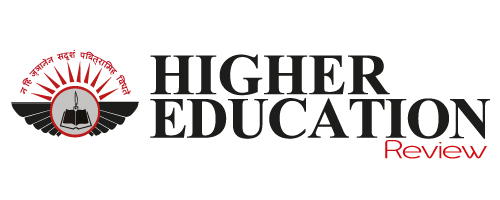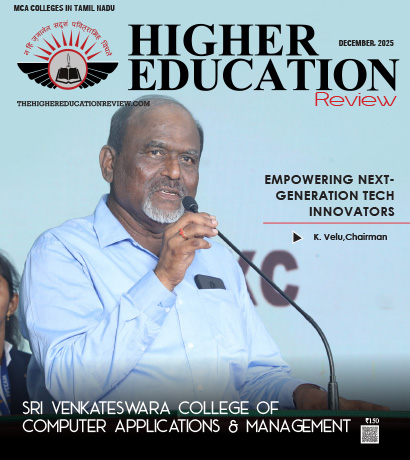How Future-Ready HR Creates Purpose-Driven Career Journeys
 In an interaction with Higher Education Review, Swati Patwardhan, CHRO, Nucleus Software, shared her views on what students and early career professionals should consider when building purpose-driven career paths in today's fast-evolving, technology-driven job market. Swati underlines the alignment of personal values with the organizational purpose, fostering cognitive ability with digital fluency. She also emphasizes the role of HR in developing a future-ready workforce and action ideas for HR leaders with inclusive development programs, industry-academia collaboration, and mentoring students as part of their overall long-term personal and professional development.
In an interaction with Higher Education Review, Swati Patwardhan, CHRO, Nucleus Software, shared her views on what students and early career professionals should consider when building purpose-driven career paths in today's fast-evolving, technology-driven job market. Swati underlines the alignment of personal values with the organizational purpose, fostering cognitive ability with digital fluency. She also emphasizes the role of HR in developing a future-ready workforce and action ideas for HR leaders with inclusive development programs, industry-academia collaboration, and mentoring students as part of their overall long-term personal and professional development.
How can a purpose-driven career journey contribute to long-term personal and professional growth?
A purpose-driven career path signifies that the organization’s purpose or work is aligned with the individual’s personal values. It is important to ensure that the organization is engaged in work that demonstrates meaningful impact. A purpose-driven career journey is an evolving process. The journey of an employee within any organization typically consists of three stages. The first stage is about learning, developing skills, and understanding about the work environment. The second stage is about earning. In this stage, the employee starts to apply the learning and earns rewards from those applications. The last stage is about giving. In this stage the employee has an aptitude for coaching and mentoring others in the learning and earning stages. A purpose-driven career journey can facilitate sustained personal and professional development.
People often find purpose through their work. When someone's sense of purpose aligns with their work, their work can provide motivation, inspiration, satisfaction, and a sense of well-being. With that alignment, individuals can contribute to the community with the work they value, and that will become their legacy. In the end, the legacy left behind holds the greatest value after a fulfilling career.
What are the most important skills that HR professionals need to empower students and graduates in shaping their career journeys?
HR professionals should possess strategic thinking, interpersonal skills, and technical skills. To assist students and graduates, HR professionals must know the curriculum especially in terms of what is covered in students' respective areas of expertise. Organizations require specific capabilities and skills. If higher education has not given students specific competencies, it is important for organizations to partner with higher education to prepare students to be employable and equip students with the knowledge, skills, and abilities to work in their roles upon entering the workforce.
Many organizations will commit to a learning curriculum or co-create the curriculum with Universities so when they onboard new graduates, the training will be relevant and purposeful. Hence, bridging this “knowing-doing” gap to align education with industry demands is essential.
Another aspect is business acumen. As an HR professional, it is essential to understand the current business environment and approach it with an eye toward the future or different business models that might arise. The ability to foresee how those changes may impact the necessary capabilities and skill sets of the talent in the organization is important. In addition, coaching and networking is an important development aspect, especially as many students are unaware of the various career pathways available to them.
HR professionals hold a unique position to provide career guidance as they see how careers unfold - from entry-level roles to leadership roles such as Managing Directors. They can provide valuable insights into various career possibilities, transferable skills, and the demand for niche expertise, as well as how people can significantly apply those skills to the best of their potential. Hence, acting as a career advisor is an important responsibility for HR professionals.,
How can students prepare themselves for future ready HR practices, especially as technology continues to impact talent management?
A majority of the process today is AI-based. Students must understand how job applications and job interviews are changing. Organizations are also changing in terms of their technology. For instance, earlier days, screening interview round is conducted by a recruiter over the phone or in person. Nowadays screening interview round is conducted as a two-minute recorded video. Once the candidate or student answers the questions, the video gets submitted to an AI application which interprets and analyzes how well and what the candidate said in their answers and gives a stack ranking of candidates who should be considered to go forward.
Students must understand how organizations use technology and AI within organizations. Another key element is digital. Other than digital fluency, cognitive aptitude is the one that will distinguish people from others. In a world where everybody is seeking tools such as ChatGPT or Gemini for answers, what stands out is being able to apply one’s own cognitive ability, knowledge, and understanding to create those answers. This true application of thought and insight will distinguish one person’s reasoning and understanding from a simple, generic response. Therefore, that is the unique selling point, which students have to work on building to illustrate.
How can HR leaders ensure that their career development programs are inclusive and catered to the diverse backgrounds, experiences and aspirations of students?
There are four key considerations when HR leaders consider creating career development programs. The first consideration is to design an accessible program. The goal is to make the program accessible to all relevant participant groups, regardless of their backgrounds, physical abilities, or aspects of diversity. As an example of an accessible program, many in-house programs function in vertical classrooms. This type of program underscores learning the skill itself, and not years of experience or job grade. With this model, anyone who has an interest and willingness to learn can access the training. This model allows for inclusion and promotes an organizational culture of continuous learning.
The second aspect is promoting diverse role models. It is crucial to foster inclusivity in terms of portraying leaders within the organization who come from diverse backgrounds. The third aspect is feedback. Providing regular and constructive feedback to students or employees in any development program is vital. Feedback provides the opportunity for growth of the employee or student in the program. The fourth aspect is learning and career alignment. If an employee or student aspires to be innovative and contribute to technologically advanced solutions, the organization must support this purpose through its culture, opportunities, and policies. Additionally, it should provide aligned learning opportunities and clear career pathways to promote such aspirations. HR leaders should consider all of these elements and integrate them into the development framework.
What steps can HR departments take to collaborate with educational institutions and help students prepare for the challenges of tomorrow's job market?
Co-developing curriculum is an approach that HR departments and organizations can pursue together with universities. Another productive strategy is sharing in-house case studies with academic programs to allow students to consider those situations as part of their learning experience. However, there are hackathons and case study competitions that expose students to real organizational problems, and students come together in groups and solve those for the organization. Organizations also benefit from these programs, as they receive new ideas and perspectives that can add a source of insight to their knowledge from a young generation. Moreover, through these programs, students can develop confidence to engage with organizational leaders and subject matter experts.

